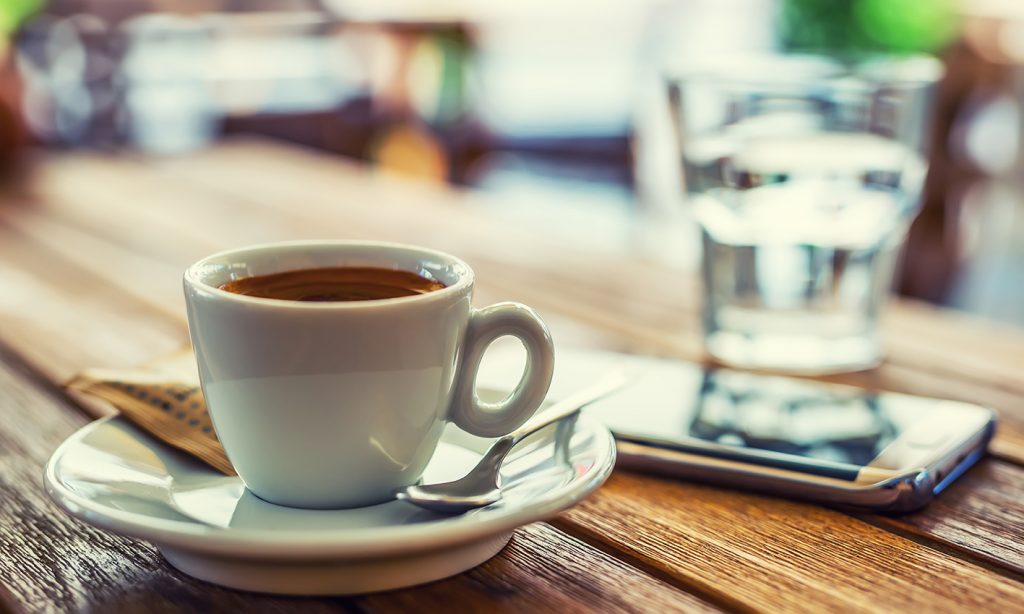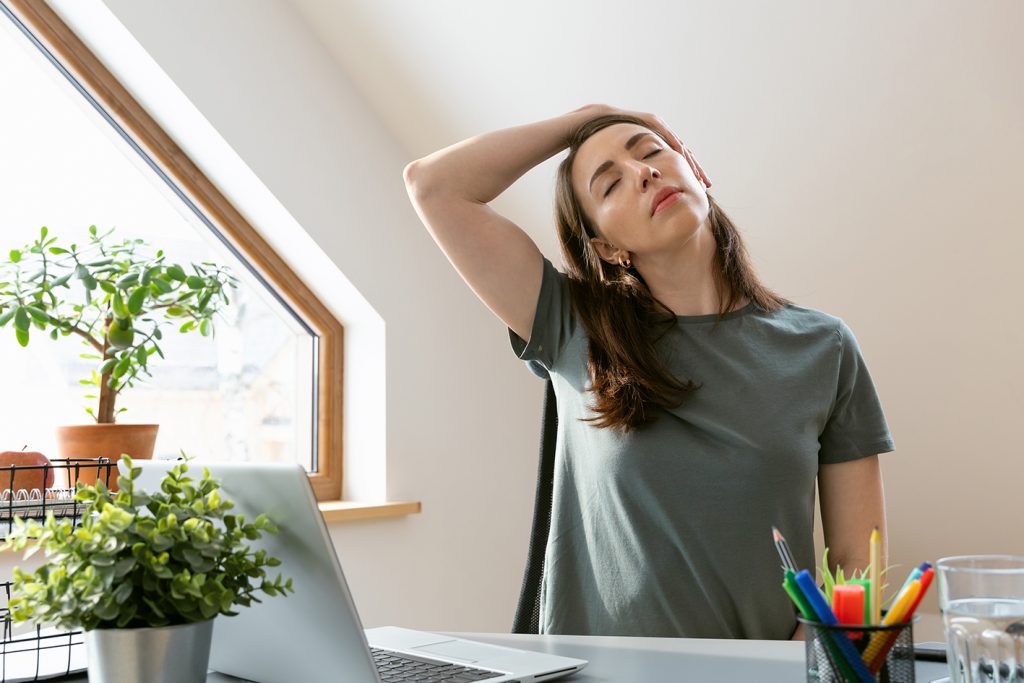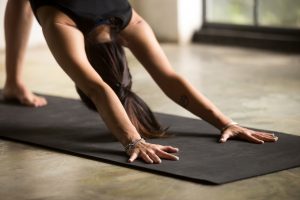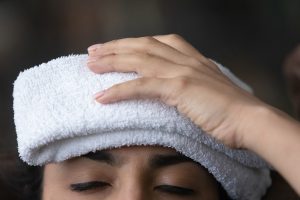What is a headache?
Headache, or head pain, is very common and, depending on the type, it usually goes away on its own. A headache tends to last anywhere between 30 minutes and a few hours.1
Headache causes
The most common headache causes are:1
- Having a virus like cold or flu
- Being stressed, which can make the muscles tense up, especially around the neck and shoulders
- Drinking too much alcohol
- Having bad posture – being hunched over
- Problems with eye sight
- Skipping a meal
- Being dehydrated
- Taking too many painkillers
- For women, before or during a period, and during the menopause

There is evidence to show that drinking coffee can increase the risk of headaches, but it’s thought that this is due to large quantities of coffee,2 so it’s probably best to consume it in moderation.
Headaches commonly occur alongside neck pain.3 Given this connection, it’s worth trying self-help techniques to relieve neck pain, as these could help ease the headache at the same time. For example:4
• Take pain relief tablets, such as paracetamol or ibuprofen, or rub a pain relief gel on your neck
• Try a low, firm pillow when you sleep
• Try heat or cold packs on your neck
• Try gentle neck exercises – there are some good examples at: https://www.nhs.uk/live-well/exercise/flexibility-exercises/
Headache types
The most common primary headache types (headaches with no underlying health condition) are tension headaches, migraines and cluster headaches.5

This is the most common type of headache. It can affect both sides of the head, the neck muscles, and the eyes. It doesn’t normally get in the way of people getting on with their work or free-time activities.6
Anyone can have a tension headache, but they’re more common in adolescents and adults, and women tend to get more headaches than men.
Tension headaches are described as chronic if someone has them for around 50% of the time, over a period of months, or even longer.
Cluster headaches are very painful, and usually occur on one side of the head, around the eye. Anyone can have one, but they’re more common in men and are likely to start when a person is in their 30s or 40s. A cluster headache can come on very suddenly and cause a stabbing sensation. It usually affects the same side every time. The pain can make the sufferer very agitated. Other symptoms can include:
• A red, watery eye
• Drooping or swelling of the eyelid
• A small pupil
• Facial sweating
• A blocked or runny nostril
A cluster headache can last from 15 minutes to several hours and be experienced as many as eight times a day. It’s not always clear what causes them, but it is thought that risk factors include:
• Smoking
• Having a family member who gets them
• Drinking alcohol
• Strong odours, like perfume, paint or petrol
• Getting overheated while exercising
Cluster headaches tend to follow a daily pattern and can last weeks or months. If you think you are experiencing cluster headaches, you should make an appointment to see your GP. They can refer you for tests to check there’s no underlying cause. Although it’s unusual for a cluster headache to be a sign of a serious health condition, due to their frequency and the pain they cause they can have a negative effect on a person’s quality of life. It’s important to get help, because there are various treatments that can relieve the symptoms.
If you’re diagnosed with cluster headaches, you’ll most likely receive a prescription treatment, as pain relieving medications you can buy ‘off the shelf’ are unlikely to work on this type of sudden pain.
Try and avoid potential triggers (see list above) if you can.
Headache symptoms
These vary depending on the type of headache, but there can be pain in one side or both sides of the head, the neck muscles, and the eyes. It can feel like a stabbing sensation.6,7
Headache pain relief
Self care for ‘normal’ (tension) headaches 6
The type of headache you’re most likely to get is a tension headache, and there are various things you can do to try and avoid them, or to relieve the pain if you get them.

Try and do things that relax you, such as:
• Yoga or pilates – these can also help with good posture, to help avoid tension headaches
• Having a massage
• Any form of exercise that you enjoy
• Acupuncture – a course of sessions may help

Make sure you’re not dehydrated. Drink plenty of water or diluted fruit juice. Try not to skip meals, or have a snack if you don’t have time for a proper meal. Be careful about how you consume alcohol, and how much you have. Avoid mixing your drinks and aim to stay within the recommended limit of 14 units a week.
Some people find they get headaches after eating certain types of food, so it could be worth keeping a food diary to see if you can identify any triggers.

A cool compress on the forehead may help (a cold, damp flannel will do) or put a warm, damp flannel on the back of your neck.

Both paracetamol and ibuprofen can be taken to help relieve a normal headache.
You could try Solpadeine Headache, which is designed to get to work fast.
Treat my pain
The Solpadeine range of clinically proven dual and triple action painkillers deliver pain relief when you need it most

References:
1. NHS: Headaches. Available at: https://www.nhs.uk/conditions/headaches/ Accessed July 2021.
2. Wachamo HL. Review on Health Benefit and Risk of Coffee Consumption. Medicinal & Aromatic Plants 2017. DOI:10.4172/2167-0412.1000301 Available at: https://www.researchgate.net/profile/Hailulire-Wachamo/publication/327241743_Review_on_Health_Benefit_and_Risk_of_Coffee_Consumption/links/5e79c7254585158bd501ca05/Review-on-Health-Benefit-and-Risk-of-Coffee-Consumption.pdf Accessed July 2021.
3. Castien R & De Hertogh W. A Neuroscience Perspective of Physical Treatment of Headache and Neck Pain. Front Neurol 2019. https://doi.org/10.3389/fneur.2019.00276
4. NHS: Neck Pain. Available at: https://www.nhs.uk/conditions/neck-pain-and-stiff-neck/ Accessed July 2021.
5. Carbaat PA, Couturier EG. [Headache: classification and diagnosis]. Nederlands Tijdschrift Voor Tandheelkunde 2016. 123(11):539-544. DOI: 10.5177/ntvt.2016.11.16122.
6. NHS: Tension headaches. Available at: https://www.nhs.uk/conditions/tension-headaches/ Accessed July 2021.
7. NHS: Cluster headaches. Available at: https://www.nhs.uk/conditions/cluster-headaches/ Accessed July 2021.
Solpadeine® Max Soluble Tablets, Paracetamol 500mg, Codeine Phosphate Hemihydrate 12.8mg, Caffeine 30mg For the treatment of acute moderate pain which is not relieved by paracetamol or ibuprofen alone. Contains codeine. Can cause addiction. Use for 3 days only. Always read the leaflet.
Solpadeine® Headache Soluble Tablets contain Paracetamol and Caffeine – a mild analgesic and antipyretic formulated to give extra pain relief. Always read the leaflet.
Solpadeine® Plus, Solpadeine® Max and Solpadeine® Headache products are not recommended for children under 12 years of age.
SolpaOne® 1000mg Effervescent Tablets contains paracetamol only. For the treatment of mild to moderate pain and/or fever. For adults and adolescents over 50kg of body weight aged 16 years and above. Always read the leaflet.

